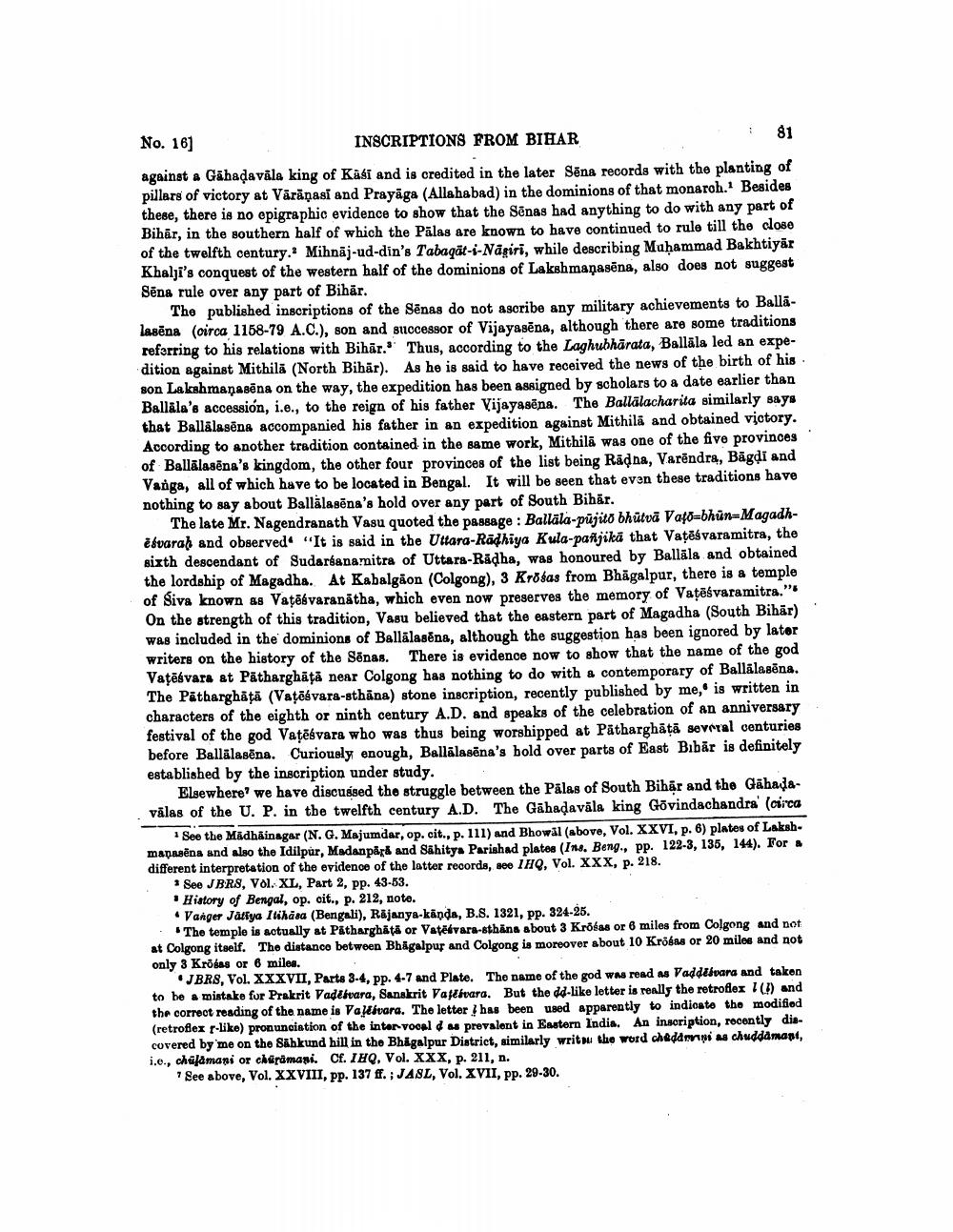________________
No. 16)
INSCRIPTIONS FROM BIHAR
1
81
against a Gähadavāla king of Kasi and is credited in the later Sēns records with the planting of pillars of victory at Värānasi and Prayāga (Allahabad) in the dominions of that monarch. Besides these, there is no epigraphic evidence to show that the Sēnas had anything to do with any part of Bihar, in the southern half of which the Pālas are known to have continued to rule till the close of the twelfth century. Mihnāj-ud-din's Tabaqät-i-Nasiri, while describing Muḥammad Bakhtiyar Khalji's conquest of the western half of the dominions of Lakshmaņasēna, also does not suggest Sēna rule over any part of Bihār.
The published inscriptions of the Sēnas do not ascribe any military achievements to Ballalasēna (circa 1158-79 A.C.), son and successor of Vijayasēna, although there are some traditions referring to his relations with Bihär.' Thus, according to the Laghubharata, Ballāla led an expedition against Mithila (North Bihär). As he is said to have received the news of the birth of his son Lakshmanasēna on the way, the expedition has been assigned by scholars to a date earlier than Ballâla's accession, i.e., to the reign of his father Vijayasēna. The Ballālacharita similarly says that Ballalasēna accompanied his father in an expedition against Mithila and obtained victory. According to another tradition contained in the same work, Mithila was one of the five provinces of Ballālasēna's kingdom, the other four provinces of the list being Rādna, Varēndra, Bāgdi and Vanga, all of which have to be located in Bengal. It will be seen that even these traditions have nothing to say about Ballálasēna's hold over any part of South Bihär.
The late Mr. Nagendranath Vasu quoted the passage : Ballāla-pujito bhütvā Vafð=bhün=Magadhēsvarah and observed "It is said in the Uttara-Radhiya Kula-pafljika that Vateśvaramitra, the sixth descendant of Sudarsanamitra of Uttara-Radha, was honoured by Ballala and obtained the lordship of Magadhe. At Kabalgaon (Colgong), 3 Krosas from Bhagalpur, there is a temple of Siva known as Vatēšvaranātha, which even now preserves the memory of Vatēśvaramitra." On the strength of this tradition, Vasu believed that the eastern part of Magadha (South Bihar) was included in the dominions of Ballälasēna, although the suggestion has been ignored by later writers on the history of the Sēnas. There is evidence now to show that the name of the god Vatē vara at Patharghātā near Colgong has nothing to do with a contemporary of Ballklasēna. The Patharghäță (Vatēsvara-sthana) stone inscription, recently published by me, is written in characters of the eighth or ninth century A.D. and speaks of the celebration of an anniversary festival of the god Vatēsvara who was thus being worshipped at Patharghātā several centuries before Ballälasēna. Curiously enough, Ballālasēna's bold over parts of East Bibār is definitely established by the inscription under study.
Elsewhere we have discussed the struggle between the Palas of South Bihar and the Gahalavålas of the U. P. in the twelfth century A.D. The Gahadavāla king Govindachandra (circa
See the Mädhāinagar (N. G. Majumdar, op. cit., p. 111) and Bhowal (above, Vol. XXVI. p. 6) plates of Lakshmanasēna and also the Idilpur, Madanpåra and Sahitya Parishad plates (Ins. Beng., pp. 122-3, 135, 144). For different interpretation of the evidence of the latter records, see IHQ, Vol. XXX, p. 218.
* See JBRS, Vol. XL, Part 2, pp. 43-53.
History of Bengal, op. cit., p. 212, note. • Vanger Jaliya Itihasa (Bengali), Rajanya-kända, B.S. 1321, pp. 324-25.
. The temple is actually at Pitharghātā or Vatekvara-sthåns about 3 Krosas or 6 miles from Colgong and not at Colgong itself. The distance between Bhagalpur and Colgong is moreover about 10 Krosas or 20 miles and not only 3 Krobas or 6 miles.
JBRS, Vol. XXXVII, Parts 3-4, pp. 4-7 and Plate. The name of the god was read as Vaddisvara and taken to be a mistake fur Prakrit Vad bara, Sanskrit Vaftara. But the dd-like letter is really the retroflex 1(!) and the correct reading of the name is Vallávara. The letter has been used apparently to indicate the modified (retroflex r-like) pronunciation of the inter voorld as prevalent in Eastern India. An inscription, recently discovered by me on the Sahkund hill in the Bhagalpur District, similarly with the word cheddams as chuddamani, i.e., chúlamani or cheamasi. Cf. IHQ, Vol. Xxx, p. 211, n.
* See above, Vol. XXVIII, pp. 137 ff.; JASL, Vol. XVII, pp. 29-30.




